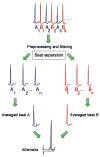Microvolt T-wave alternans physiological basis, methods of measurement, and clinical utility--consensus guideline by International Society for Holter and Noninvasive Electrocardiology
- PMID: 21920259
- PMCID: PMC4111570
- DOI: 10.1016/j.jacc.2011.06.029
Microvolt T-wave alternans physiological basis, methods of measurement, and clinical utility--consensus guideline by International Society for Holter and Noninvasive Electrocardiology
Abstract
This consensus guideline was prepared on behalf of the International Society for Holter and Noninvasive Electrocardiology and is cosponsored by the Japanese Circulation Society, the Computers in Cardiology Working Group on e-Cardiology of the European Society of Cardiology, and the European Cardiac Arrhythmia Society. It discusses the electrocardiographic phenomenon of T-wave alternans (TWA) (i.e., a beat-to-beat alternation in the morphology and amplitude of the ST-segment or T-wave). This statement focuses on its physiological basis and measurement technologies and its clinical utility in stratifying risk for life-threatening ventricular arrhythmias. Signal processing techniques including the frequency-domain Spectral Method and the time-domain Modified Moving Average method have demonstrated the utility of TWA in arrhythmia risk stratification in prospective studies in >12,000 patients. The majority of exercise-based studies using both methods have reported high relative risks for cardiovascular mortality and for sudden cardiac death in patients with preserved as well as depressed left ventricular ejection fraction. Studies with ambulatory electrocardiogram-based TWA analysis with Modified Moving Average method have yielded significant predictive capacity. However, negative studies with the Spectral Method have also appeared, including 2 interventional studies in patients with implantable defibrillators. Meta-analyses have been performed to gain insights into this issue. Frontiers of TWA research include use in arrhythmia risk stratification of individuals with preserved ejection fraction, improvements in predictivity with quantitative analysis, and utility in guiding medical as well as device-based therapy. Overall, although TWA appears to be a useful marker of risk for arrhythmic and cardiovascular death, there is as yet no definitive evidence that it can guide therapy.
Copyright © 2011 American College of Cardiology Foundation. Published by Elsevier Inc. All rights reserved.
Figures








Comment in
-
Microvolt T-wave alternans testing has no role at present in guiding therapy for patients at high risk of ventricular arrhythmias.J Am Coll Cardiol. 2012 Feb 28;59(9):856. doi: 10.1016/j.jacc.2011.10.897. J Am Coll Cardiol. 2012. PMID: 22361408 No abstract available.
References
-
- Hering HE. Experimentelle Studien an Säugethieren über das Elektrocardiogram. Zschr Exper Path Therapie. 1909;7:363–78.
-
- Oshodi GO, Wilson LD, Costantini O, Rosenbaum DS. Microvolt T wave alternans: mechanisms and implications for prediction of sudden cardiac death. In: Gussak I, Antzelevitch C, Wilde AAM, Friedman P, Ackerman M, Shen WK, editors. Electrical Diseases of the Heart: Genetics, Mechanisms, Treatment, Prevention. New York, NY: Springer-Verlag; 2007. pp. 394–408.
-
- Chinushi M, Kozhevnikov D, Caref EB, Restivo M, El-Sherif N. Mechanism of discordant T wave alternans in the in vivo heart. J Cardiovasc Electrophysiol. 2003;14:632–8. - PubMed
-
- Narayan SM. T-wave alternans and the susceptibility to ventricular arrhythmias. J Am Coll Cardiol. 2006;47:269–81. - PubMed
Publication types
MeSH terms
Grants and funding
LinkOut - more resources
Full Text Sources
Other Literature Sources

